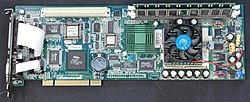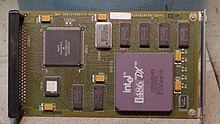
SunPCi is a series of single-board computers with a connector that effectively allows a PC motherboard to be fitted in Sun Microsystems SPARC-based workstations based on the PCI architecture adding the capability for the workstation to act as a 'IBM PC compatible' computer. The Sun PCi cards included an x86 processor, RAM, expansion ports, and an onboard graphics controller, allowing a complete Wintel operating environment on a Solaris system. The SunPCi software running on Solaris emulates the disk drives that contain the PC filesystem. The PC software running on the embedded hardware is displayed in an X window on the host desktop; there is also a connector on the edge of the board that can optionally be used to connect a PC monitor.
History
The product arose from the issue of people who were working on a Unix workstation that was typically not Intel-based being sent a file from a Microsoft Windows based PC and being unable to handle the file. Sun termed this problem interoperability. By the year 2000 solutions to the problem such as emulators were available but their performance at the time was quite problematic. With Sun workstations adopting the PCI hardware bus standard this became possible.

These cards were the successor to the earlier SunPC cards that had been available for Sun SBus or VME systems. Prior to this a software only application binary interface and DOS emulator called Wabi was used. SunPC was offered as a replacement software emulator that could be used to run more advanced applications, with higher performance, by adding an X86 hardware accelerator. In 1992 the SunPC Accelerator SX (16 MHz 486SX) or SunPC Accelerator DX (25 MHz 486DX) were available for SBus workstations, though the SunPC program emulates the PC memory with or without the accelerator present. An accelerator card is needed for software that requires 80386 or 80486 hardware, such as Windows 3.11 running in enhanced mode or Windows 95; without this hardware SunPC runs in software-only mode which emulates an 80286. In 1997 a 133 MHz 5x86 AMD SBus co-processor was available.

The Ultra 5 workstation with an optional SunPCi for running Windows 95 or NT was announced in November 1998. The next year Ultra 5 systems including a SunPCi with a 300 MHz AMD K6-2 processor and 64 to 256 MB RAM were available. Windows applications running on this system were measured to be 40% slower than a desktop PC with a 300 MHz Pentium II, but the card was cheaper than purchasing a new PC. Following an in-depth review in 1999 with an original 300MHz 64mb memory SunPCi card, Kevin Railsback in InfoWorld magazine noted the price was competitive and the performance was suitable for business applications especially when using the output attached to the SunPCi to a dedicated monitor. The downsides were that a separate license was required for the Windows 95 operating system, MS-DOS disk drivers performed slowly and DirectX was not available unless using the separate dedicated monitor. The 600 MHz SunPCi II was introduced in 2000. With the release of version 2.2 of the SunPCi II software in 2001 it was possible to have more than one accelerator card in a workstation or entry-level Sun Enterprise server. By 2005 the SunPCi IIIpro was available for workstations such as the Sun Blade 150.
Hardware and software
Hardware
According to Sun documentation the "... coprocessor card is not just PC-compatible, it is an actual PC that is constructed from real PC components and follows the de facto and emerging PC hardware design standards."
| Model | CPU type | Clock speed | Part number |
|---|---|---|---|
| SunPCi | AMD K6-2 | 300 MHz | 375-0075 |
| SunPCi | AMD K6-2 | 400 MHz | 375-0095 |
| SunPCi II | 600 MHz | 375-0131 | |
| SunPCi IIpro | 733 MHz | 375-3051 | |
| SunPCi III | 1.4 GHz | 375-3116 | |
| SunPCi IIIpro | 1.6 GHz | 375-3203 |
Software
The SunPCi I coprocessor with version 1.3 software, the final release for SunPCi I hardware, is compatible with Solaris 2.5.1, 2.6, 7 or 8 running on the host. Solaris 9 support was included starting with the SunPCi II hardware and version 2.3.1 software. The SunPCi III is supported on Solaris 10 with patches, but SunPCi II is not.
The first version of the SunPCi card was intended to run Windows 95 or NT. The cards were not limited to just "officially" supported operating systems; according to Sun "Because the card is a PC system, future Microsoft Windows operating systems should also be compatible." Later, the following Windows and Linux operating systems were officially supported by Sun on the SunPCi IIIpro:
- Microsoft Windows XP
- Microsoft Windows 2000 Professional
- Microsoft Windows 2000 Server
- Microsoft Windows 2003 Server
- Red Hat 9 Personal/Professional
- Red Hat Enterprise Linux 3 WS/ES
Some people have also claimed to successfully run some other operating systems on particular SunPCi cards, including NetBSD and Debian Linux
See also
- Sun386i, Sun Microsystems Intel based workstation product
Notes
- Sun microsystems tended to use the term operating environment where many would simply use operating system, there may be some specific reasoning behind the different terminology.
- Later documentation retroactively refers to the first generation "SunPCi" as "SunPCi I."
References
- ^ Tougaw, Douglas (15 August 2000). "Sun PCi Provides the Best of Two Worlds". Computing in Science & Engineering. 42 (4). IEEE/AIP: 4–8. Bibcode:2000CSE.....2d...4T. doi:10.1109/MCISE.2000.852386.
- ^ Railsback, Kevin (April 12, 1999). "SunPCi puts Wintel in your workstation". InfoWorld. pp. 49–50. ISSN 0199-6649. Retrieved 15 December 2019.
- ^ Barker, Ralph (October 1999). "Sun's Ultra 5 with SunPCi". Performance Computing. Vol. 17, no. 11. San Francisco.
- ^ Wells, April J. (28 November 2007). "Virtualization". Grid Application Systems Design. CRC Press. pp. 177–178. ISBN 9781420012972. Retrieved 15 December 2019.
- DeVitt, Don (August 1999). SunPCi Supporting Highly Available PC Applications with Solaris (PDF) (Report). Sun Microsystems. S2CID 201656164. Archived from the original (PDF) on 2019-12-15. Retrieved 15 December 2019.
- Conover, Joel (August 1, 1995). "DOS And Windows Have Their Moment In The Sun, Thanks To SunSoft's SunPC". Network Computing.
- Wylie, Margie (April 20, 1992). "Sun seeks to connect Unix, other PC operating systems". Network World. pp. 15, 17. ISSN 0887-7661. Retrieved 15 December 2019.
- ^ SunPC 4.2 User's Guide (PDF) (Report). Sun Microsystems. November 1997. pp. 1, 8, 94–95. Retrieved 15 December 2019.
- SunPC: Just the Facts (PDF) (Report). Sun Microsystems. October 1997. Retrieved 15 December 2019.
- Comerford, R. (1999). "The changing workstation". IEEE Spectrum. 36 (5): 98. doi:10.1109/6.763200.
- Caton, Michael (May 3, 1999). "PC on a card does its job, but...". PC Week. p. 51. ISSN 0740-1604.
- "Sun debuts 600 MHz co processor card for PCI-based workstations". Computer Workstations. Vol. 13, no. 12. Boston. December 1, 2000.
- SunPCi II 2.2 Installation Guide (PDF) (Report). Sun Microsystems. March 2001. pp. 1–2. Retrieved 16 December 2019.
- Sun Blade 150 Product Notes (PDF) (Report). Sun Microsystems. July 2005. Retrieved 15 December 2019.
- ^ SunPCi IIpro (PDF) (Report). Technical White Paper. Sun Microsystems. 2001. p. 1–2. Archived from the original (PDF) on August 1, 2004. Retrieved 17 December 2019.
- "SunPCi Downloads". Sun Microsystems. Archived from the original on 11 February 2009. Retrieved 17 December 2019.
- "SunVTS 6.0 Release Notes". Oracle. Sun Microsystems. 2005. Retrieved 17 December 2019.
- Datasheet: SunPCi IIIpro (PDF) (Report). Sun Microsystems. August 2004. Archived from the original (PDF) on January 6, 2007. Retrieved 16 December 2019.
- "netbsd_sun_pci [subsole.org]". www.subsole.org. Archived from the original on 2019-12-15. Retrieved 2019-12-15.
- "Linux on SunPCi-II Mini-HOWTO". www.vdberg.org. Archived from the original on 2016-08-14. Retrieved 2019-12-15.